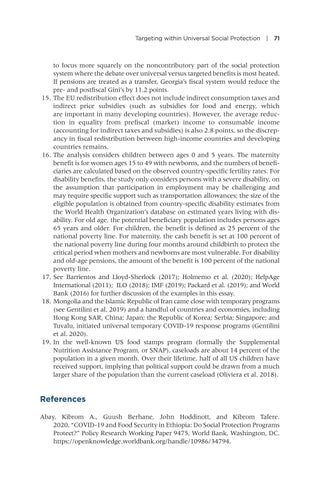Targeting within Universal Social Protection | 71
15.
16.
17.
18.
19.
to focus more squarely on the noncontributory part of the social protection system where the debate over universal versus targeted benefits is most heated. If pensions are treated as a transfer, Georgia’s fiscal system would reduce the pre- and postfiscal Gini’s by 11.2 points. The EU redistribution effect does not include indirect consumption taxes and indirect price subsidies (such as subsidies for food and energy, which are important in many developing countries). However, the average reduction in equality from prefiscal (market) income to consumable income (accounting for indirect taxes and subsidies) is also 2.8 points, so the discrepancy in fiscal redistribution between high-income countries and developing countries remains. The analysis considers children between ages 0 and 5 years. The maternity benefit is for women ages 15 to 49 with newborns, and the numbers of beneficiaries are calculated based on the observed country-specific fertility rates. For disability benefits, the study only considers persons with a severe disability, on the assumption that participation in employment may be challenging and may require specific support such as transportation allowances; the size of the eligible population is obtained from country-specific disability estimates from the World Health Organization’s database on estimated years living with disability. For old age, the potential beneficiary population includes persons ages 65 years and older. For children, the benefit is defined as 25 percent of the national poverty line. For maternity, the cash benefit is set at 100 percent of the national poverty line during four months around childbirth to protect the critical period when mothers and newborns are most vulnerable. For disability and old-age pensions, the amount of the benefit is 100 percent of the national poverty line. See Barrientos and Lloyd-Sherlock (2017); Holmemo et al. (2020); HelpAge International (2011); ILO (2018); IMF (2019); Packard et al. (2019); and World Bank (2016) for further discussion of the examples in this essay. Mongolia and the Islamic Republic of Iran came close with temporary programs (see Gentilini et al. 2019) and a handful of countries and economies, including Hong Kong SAR, China; Japan; the Republic of Korea; Serbia; Singapore; and Tuvalu, initiated universal temporary COVID-19 response programs (Gentilini et al. 2020). In the well-known US food stamps program (formally the Supplemental Nutrition Assistance Program, or SNAP), caseloads are about 14 percent of the population in a given month. Over their lifetime, half of all US children have received support, implying that political support could be drawn from a much larger share of the population than the current caseload (Oliviera et al. 2018).
References Abay, Kibrom A., Guush Berhane, John Hoddinott, and Kibrom Tafere. 2020. “COVID-19 and Food Security in Ethiopia: Do Social Protection Programs Protect?” Policy Research Working Paper 9475, World Bank, Washington, DC. https://openknowledge.worldbank.org/handle/10986/34794.


